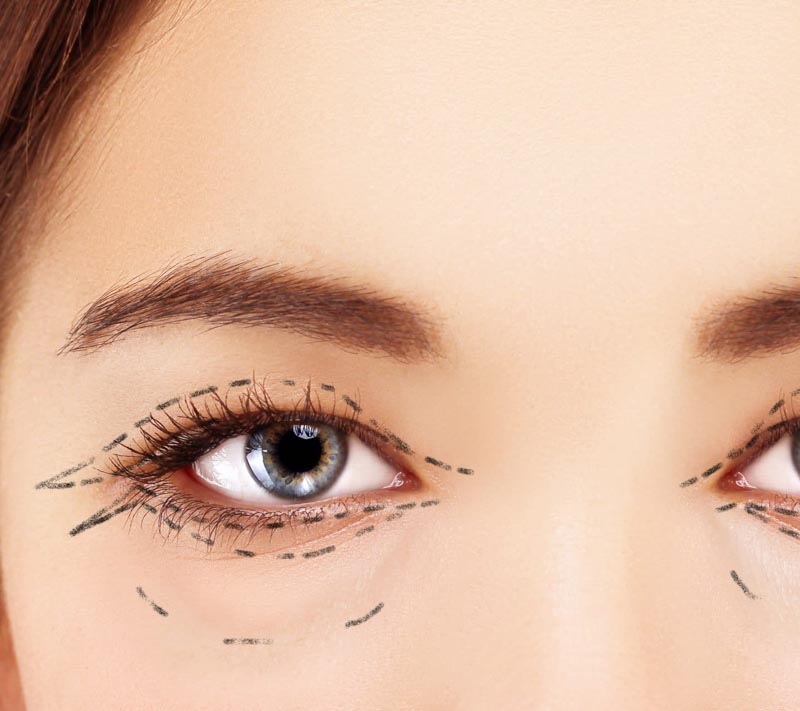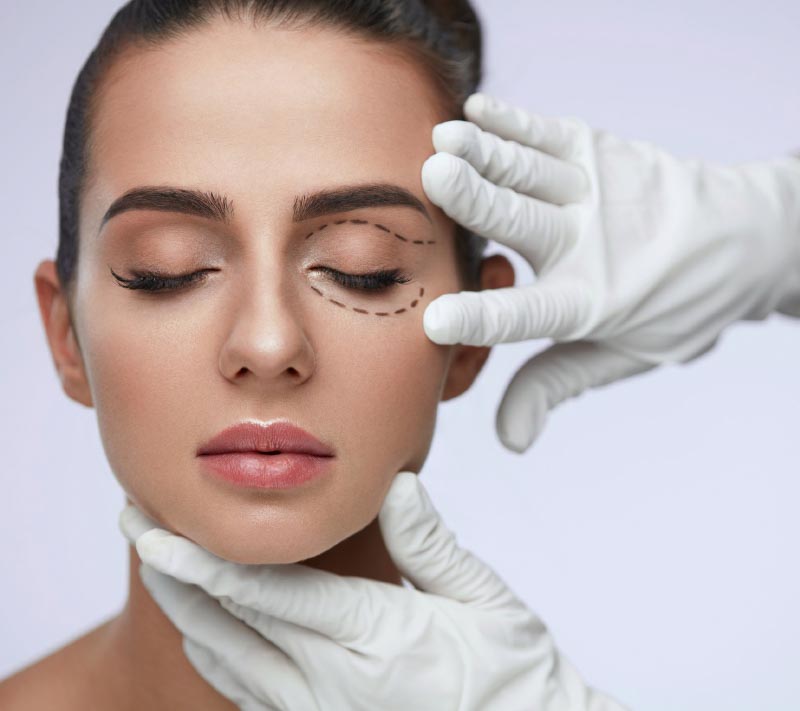
Eyelid Surgery
Dr. Shaun Parson Plastic Surgery & Skin Center specializes in eyelid surgery. Also known as blepharoplasty (blef-r-o-plasty), eyelid surgery can be performed on the upper lids, lower lids, or both. Doing both the upper lids and lower lids at the same time is often referred to as a “quad bleph” or quad blepharoplasty. Often times this procedure provides the most dramatic results and can help patients look several years younger. Blepharoplasty is also a fantastic preventative surgery. Please note that eyelid surgery does not address crow’s feet lines, dark pigmentation of lower eyelids or drooping eyebrow skin.
Eyelid surgery is frequently done at the same time as other facial procedures, such as a facelift or brow lift, and can be combined with laser or chemical resurfacing to smooth skin wrinkles.
The quad blepharoplasty procedure typically takes around two hours to complete. This timeframe allows for meticulous attention to detail, ensuring that the results meet your aesthetic goals. While the procedure itself is relatively swift, it’s essential to account for preparation and recovery time as part of your planning. Remember that individual experiences may vary slightly, but you can generally expect to be in and out in approximately a couple of hours.
How Skin Laxity Around the Eye is Unique
Doing both the upper lids and lower lids at the same time is often referred to as a “quad bleph” or quad blepharoplasty. Often times, this procedure provides the most dramatic results and can help patients look several years younger. Blepharoplasty is also a fantastic preventative surgery.
Why Consider Quad Blepharoplasty?
- Comprehensive Solution: This dual approach addresses multiple aesthetic concerns in one procedure, tackling the tired look and bags under the eyes effectively.
- Convenience: By combining the upper and lower eyelid surgeries, patients can avoid multiple recoveries, making the process more efficient and less time-consuming.
- Youthful Appearance: The procedure works by removing excess skin and fat, which reduces puffiness and wrinkling around the eyes, resulting in a more youthful and inviting appearance.
- Confidence Boost: Many patients choose this surgery to feel more confident in photos and everyday interactions, as it helps them look more alert and rejuvenated.
Incorporating these benefits, quad blepharoplasty not only enhances one’s appearance but also provides a practical solution for those looking to maintain a youthful look with minimal disruption to their lives.
How is Quad Blepharoplasty Performed?
This cosmetic surgery is typically performed as an outpatient procedure, allowing you to return home the same day. The procedure can be done under local anesthesia or IV sedation, ensuring comfort while you remain aware.
Types of Anesthesia Used
Quad blepharoplasty offers flexibility in anesthesia options. Whether you choose local anesthesia, which numbs the specific area, or IV sedation, which provides a more relaxed state, both methods are designed to maintain your comfort and safety throughout the procedure. This ensures a tailored experience based on your personal needs and medical recommendations.
By combining these options, the procedure aims to offer a seamless and stress-free experience, allowing you to focus on your recovery and the positive results ahead.
Here’s what to expect during the procedure:
- Incision Marks: Once you’re sedated, precise incision marks are made on your eyelids. This step is crucial for ensuring natural-looking results.
- Eyelid Adjustments: Adjustments are made to both the upper and lower eyelids as necessary. Your surgeon may ask you to look in different directions to fine-tune the results.
- Sutures and Bandages: After the adjustments, the sutures are carefully covered with bandages. Rest assured, you will still be able to see around them.
The entire procedure is typically completed within two hours, making it both efficient and effective in rejuvenating your appearance. With the right expertise, a quad blepharoplasty can transform your look, helping you achieve a youthful and refreshed appearance.
Oftentimes, age isn’t the only factor that causes sagging around the eyes. Therefore, any healthy adult could possibly reap the benefits from having a blepharoplasty depending on their specific concern.
You might be a suitable candidate for quad blepharoplasty if you frequently hear comments about looking tired, or if you notice persistent bags under your eyes that don’t go away with rest. Many patients consider this procedure when they feel they appear older in photos, struggle to see their makeup properly, or simply desire a refreshed appearance.
By addressing these particular issues, blepharoplasty can be an effective solution for those looking to rejuvenate their appearance and boost their confidence. Whether your concern is cosmetic or functional, understanding your specific needs is the first step towards determining if this surgery is right for you.
Every person will experience skin sagging and laxity around the eyes as they grow older. The technical term for upper eyelid sagging is ptosis.
Ptosis can be caused from lost collagen due to age, from the levator muscle wearing out, or from trauma that may have damaged the muscles. There are tiny muscles in charge of lifting the eyelid, and just like any other muscle that is used non-stop, they can get tired and weak over time.
Sometimes the trauma to this area is acute. For instance, there are some cases where aggressive eye-rubbing has caused ptosis. While this isn’t the norm, as eyelid sagging is usually partially age-related and partially genetic, it is something to keep in mind.
Patients are always pleasantly surprised at just how quick blepharoplasty surgery is and how swift the recovery period tends to be. Incisions are very tiny and easily hidden in the creases of the eyelid. You might experience some swelling and light bruising after a blepharoplasty procedure, but that goes away on its own usually 1 – 2 weeks post-surgery. To help minimize swelling, consider applying ice packs gently to the affected area. This simple step can make a significant difference in your comfort and recovery speed.
Despite the initial swelling, you’ll likely be able to continue with most of your daily activities without much disruption. Remember, everyone’s healing process is unique, so it’s important to listen to your body and give yourself the necessary time to recover. By following these tips and maintaining a relaxed routine, you’ll be on your way to seeing the full benefits of your surgery in just a couple of weeks.
The results are immediate, except for any swelling, and help you look not only younger but healthier, happier, and more alert while still maintaining a natural look.
Lower Blepharoplasty
Lower eyelids present their own kinds of problems. This is usually where one might first notice fine lines and wrinkles, and these imperfections will just get deeper and more severe with age and sun damage. Wrinkling below the eyelids can make a person look much older, and even keep them from smiling in photos and fully enjoying life. Wrinkling is typically due to lost collagen and sun damage, but can be exacerbated by innocent trauma such as eye-rubbing.
Bags, dark circles, and fat pockets are additional common issues in the lower eyelid. Everyone loses “good fat” in their face as they age, and this loss is rarely completely symmetrical. You might have bags from fat pockets, skin laxity, or both. Bags can also cause or worsen undereye circles. These circles might be caused by shadows, or could be more prominent now that fat has been lost from this critical area.
A lower blepharoplasty lifts and tightens the skin in this area. In some cases, the lower lid itself is tightened at the outer corner of the eye socket to correct laxity of the tone of the lower eyelid (canthoplasty). Complementary procedures include fat removal if pockets exist or a fat transfer in order to restore fat to the area to fill in hollowed areas and dramatically reduce circles. There are two incision locations possible for a lower bleph, either along the lower lashline or inside the eyelid. Both are very discrete, and the location is determined based on your unique lower blepharoplasty.

Lower Blepharoplasty

Lower eyelids present their own kinds of problems. This is usually where one might first notice fine lines and wrinkles, and these imperfections will just get deeper and more severe with age and sun damage. Wrinkling below the eyelids can make a person look much older, and even keep them from smiling in photos and fully enjoying life. Wrinkling is typically due to lost collagen and sun damage, but can be exacerbated by innocent trauma such as eye-rubbing.
Bags, dark circles, and fat pockets are additional common issues in the lower eyelid. Everyone loses “good fat” in their face as they age, and this loss is rarely completely symmetrical. You might have bags from fat pockets, skin laxity, or both. Bags can also cause or worsen undereye circles. These circles might be caused by shadows, or could be more prominent now that fat has been lost from this critical area.
A lower blepharoplasty lifts and tightens the skin in this area. In some cases, the lower lid itself is tightened at the outer corner of the eye socket to correct laxity of the tone of the lower eyelid (canthoplasty). Complementary procedures include fat removal if pockets exist or a fat transfer in order to restore fat to the area to fill in hollowed areas and dramatically reduce circles. There are two incision locations possible for a lower bleph, either along the lower lashline or inside the eyelid. Both are very discrete, and the location is determined based on your unique lower blepharoplasty.
Is an Eyelid Lift for You?
Whether you’ve just started to notice signs of aging around the eyes or you’ve been struggling for some time with laxity, bags, or circles, a blepharoplasty procedure is a relatively quick procedure with very little downtime. It is also a great complement to other surgeries such as facelifts, browlifts, fat transfer or dermal fillers. The latter can be injected in many parts of the face for a more youthful appearance. Getting back the eyes you love starts with a consultation. Dr. Parson will work with you to determine your needs by developing a customized plan just for you.
Post-Operative Care
Post-Operative Care After Quad Blepharoplasty
After undergoing quad blepharoplasty, following a structured post-operative care routine can significantly aid your recovery and minimize discomfort.
Managing Pain and Discomfort
Most patients experience just mild discomfort after the procedure. To alleviate any pain, consider using over-the-counter pain relievers like ibuprofen or acetaminophen. These can help manage any lingering soreness.
Handling Stitches and Swelling
The surgery typically involves the use of dissolvable stitches, which should naturally dissolve within 7 to 10 days. Alongside, you might notice bruising and swelling, which generally decrease over a similar timeframe. It may take 1 to 2 weeks for the entire swelling to subside. However, you won’t have any difficulties performing most activities within 1 to 2 days.
To address swelling, applying ice packs is recommended. This not only helps reduce puffiness but also provides soothing relief. You should be able to perform most activities even with modest swelling, which is reassuring for maintaining your daily routine.
Resuming Daily Activities
You’ll likely be able to carry on with most regular activities despite moderate swelling. While complete swelling resolution can take up to 1 to 2 weeks, you should find yourself capable of resuming usual tasks within just a couple of days post-surgery.
Follow-Up Appointments
A follow-up appointment with your surgeon is typically scheduled about a week after the procedure. This visit is crucial to ensure that everything is healing properly and to address any concerns you might have.
Adhering to these post-operative care guidelines can enhance your healing process and help you achieve the best possible results from your quad blepharoplasty.



